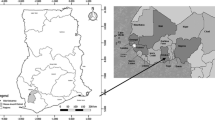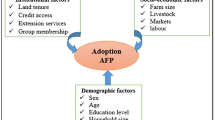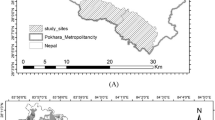Abstract
Farm-level tree planting has been suggested to have potential to decrease pressures on natural forests and, consequently, contribute towards reducing deforestation and forest degradation. However, the scientific evidence for such a link is limited. We examined farmers’ beliefs, attitudes and behaviours in relation to tree planting on farms and cutting down trees from the forest, as one way of establishing this link. A household survey was administered to 200 farmers in two rural districts in Malawi, which included an attitude scale based on the theory of planned behaviour. The results showed that farmers in Malawi recognise the benefits of planting trees, feel encouraged by fellow farmers, and feel capable of planting trees on their land. In addition, they believe cutting down trees from the forest will result in mainly negative outcomes, and feel discouraged by others and hindered by control factors to cut down trees from the forest. In total, 76 % of respondents planted trees in the past 5 years, 50 % collected firewood from the forest and 21 % collected poles. There was no evidence for a direct relationship between attitudes towards planting trees and cutting down trees, nor were the behaviours in relation to tree planting and cutting down trees from the forest significantly associated. However, there was evidence for an indirect relationship between tree planting behaviour and cutting down trees from the forest, as respondents who had planted trees had more negative attitudes towards cutting down trees from the forest. Future research should further explore the direct relationship between agroforestry and deforestation to establish if and under what conditions such a relationship might exist.

Similar content being viewed by others
References
Abbot J, Homewood K (1999) A history of change: causes of miombo woodland decline in a protected area in Malawi. J Appl Ecol 36:422–433
Ajayi OC, Akinnifesi FK, Sileshi GW, Kanjipite W (2009) Labour inputs and financial profitability of conventional and agroforestry-based soil fertility management practices in Zambia. Agrekon 48:276–292
Ajzen I (1991) The theory of planned behavior. Organ Behav Hum Decis Process 50:179–211
Ajzen I (2012) Values, attitudes, and behavior. In: Salzborn S, Davidov E, Reinecke J (eds) Methods, theories, and empirical applications in the social sciences. VS Verlag für Sozialwissenschaften, Wiesbaden, pp 33–38
Akinnifesi FK, Makumba W, Kwesiga FR (2006) Sustainable maize production using gliricidia/maize intercropping in southern Malawi. Exp Agric 42:441–457
Akinnifesi FK, Makumba W, Sileshi GW, Ajayi OC, Mweta D (2007) Synergistic effect of inorganic N and P fertilizers and organic inputs from Gliricidia sepium on productivity of intercropped maize in Southern Malawi. Plant Soil 294:203–217
Armitage CJ, Conner M (2001) Efficacy of the theory of planned behaviour: a meta-analytic review. Br J Soc Psychol 40:471–499
Ashley R, Russell D, Swallow B (2006) The policy terrain in protected area landscapes: challenges for agroforestry in integrated landscape conservation. Biodivers Conserv 15:663–689
Bhagwat SA, Willis KJ, Birks HJB, Whittaker RJ (2008) Agroforestry: a refuge for tropical biodiversity? Trends Ecol Evol 23:261–267
Brouwer ID, Hoorweg JC, van Liere MJ (1997) When households run out of fuel: responses of rural households to decreasing fuelwood availability, Ntcheu District, Malawi. World Dev 25:255–266
Chapman S (1994) Tobacco and deforestation in the developing world. Tob Control 3:191
Chirwa PW, Black CR, Ong CK, Maghembe JA (2003) Tree and crop productivity in gliricidia/maize/pigeonpea cropping systems in southern Malawi. Agrofor Syst 59:265–277
FAO (2001) Forests and the forestry sector—Malawi. FAO. http://www.fao.org/forestry/country/57478/en/mwi/. Accessed 26 Feb 2014
FAO (2010) Global forest resources assessment 2010. Food and Agriculture Organization of the United Nations, Rome
Fishbein M, Ajzen I (1975) Belief, attitude, intention, and behavior: an introduction to theory and research. Addison-Wesley, Reading
French D (1986) Confronting an unsolvable problem: deforestation in Malawi. World Dev 14:531–540
Garrity DP (2004) Agroforestry and the achievement of the Millennium Development Goals. Agrofor Syst 61–2:5–17
Garrity DP, Akinnifesi FK, Ajayi OC, Weldesemayat SG, Mowo JG, Kalinganire A, Larwanou M, Bayala J (2010) Evergreen agriculture: a robust approach to sustainable food security in Africa. Food Sec 2:1–18
Hansen MC, Potapov PV, Moore R, Hancher M, Turubanova SA, Tyukavina A, Thau D, Stehman SV, Goetz SJ, Loveland TR, Kommareddy A, Egorov A, Chini L, Justice CO, Townshend JRG (2013) UMD tree cover loss and gain area. University of Maryland and Google
Hyde W, Seve J (1993) The economic role of wood products in tropical deforestation: the severe example of Malawi. For Ecol Manag 57:283–300
Izac AMN, Sanchez PA (2001) Towards a natural resource management paradigm for international agriculture: the example of agroforestry research. Agric Syst 69:5–25
Jama B, Pizarro G (2008) Agriculture in Africa: strategies to improve and sustain smallholder production systems. Ann N Y Acad Sci 1136:218–232
Jose S (2009) Agroforestry for ecosystem services and environmental benefits: an overview. Agrofor Syst 76:1–10
Kambewa PS, Mataya BF, Sichinga WK, Johnson TR (2007) Charcoal: the reality—a study of charcoal consumption, trade and production in Malawi. Small and Medium Forestry Enterprise Series No 21. International Institute for Environment and Development, London
Knoke T, Calvas B, Aguirre N, Roman-Cuesta RM, Gunter S, Stimm B, Weber M, Mosandl R (2009) Can tropical farmers reconcile subsistence needs with forest conservation? Front Ecol Environ 7:548–554
Likert R (1931) A technique for the measurement of attitudes. Columbia University Press, New York
Mauambeta DDC, Chitedze D, Mumba R, Gama S (2010) Status of forests and tree management in Malawi. A position paper prepared for the Coordination Union for Rehabilitation of the Environment (CURE)
McGinty MM, Swisher ME, Alavalapati J (2008) Agroforestry adoption and maintenance: self-efficacy, attitudes and socio-economic factors. Agrofor Syst 73:99–108
McNeely JA, Schroth G (2006) Agroforestry and biodiversity conservation—traditional practices, present dynamics, and lessons for the future. Biodivers Conserv 15:549–554
Meijer SS, Catacutan D, Ajayi OC, Sileshi GW, Nieuwenhuis M (2015a) The role of knowledge, attitudes and perceptions in the uptake of agricultural and agroforestry innovations among smallholder farmers in sub-Saharan Africa. Int J Agric Sustain 13:40–54
Meijer SS, Catacutan D, Sileshi GW, Nieuwenhuis M (2015b) Tree planting by smallholder farmers in Malawi: using the theory of planned behaviour to examine the relationship between attitudes and behaviour. J Environ Psychol 43:1–12
Meijer SS, Sileshi GW, Kundhlande G, Catacutan D, Nieuwenhuis M (2015c) The role of gender and kinship structure in household decision-making for agriculture and tree planting in Malawi. J Gend Agric Food Secur 1:51–72
Murniati, Garrity DP, Gintings AN (2001) The contribution of agroforestry systems to reducing farmers’ dependence on the resources of adjacent national parks: a case study from Sumatra, Indonesia. Agrofor Syst 52:171–184
Ngambeki DS (1985) Economic-evaluation of alley cropping Leucaena with maize-maize and maize-cowpea in Southern Nigeria. Agric Syst 17:243–258
Noble IR, Dirzo R (1997) Forests as human-dominated ecosystems. Science 277:522–525
NSO (2008) Population and housing census. National Statistical Office of Malawi, Zomba
Oppenheim AN (1992) Questionnaire design, interviewing and attitude measurement. Continuum, London
Pandey DN (2002) Carbon sequestration in agroforestry systems. Clim Policy 2:367–377
Place F, Otsuka K (2001) Population, tenure, and natural resource management: the case of customary land area in Malawi. J Environ Econ Manag 41:13–32
Pretty JN, Morison JIL, Hine RE (2003) Reducing food poverty by increasing agricultural sustainability in developing countries. Agric Ecosyst Environ 95:217–234
Ramadhani T, Otsyina R, Franzel S (2002) Improving household incomes and reducing deforestation using rotational woodlots in Tabora district, Tanzania. Agric Ecosyst Environ 89:229–239
Reyes T, Quiroz R, Msikula S (2005) Socio-economic comparison between traditional and improved cultivation methods in agroforestry systems, East Usambara Mountains, Tanzania. Environ Manag 36:682–690
Sanchez PA, Swaminathan MS (2005) Cutting world hunger in half. Science 307:357–359
Sanchez PA, Buresh RJ, Leakey RRB (1997) Trees, soils, and food security. Philos Trans R Soc Lond B 352:949–960
Sileshi GW, Akinnifesi FK, Ajayi OC, Place F (2008) Meta-analysis of maize yield response to woody and herbaceous legumes in sub-Saharan Africa. Plant Soil 307:1–19
Steffan-Dewenter I, Kessler M, Barkmann J, Bos MM, Buchori D, Erasmi S, Faust H, Gerold G, Glenk K, Gradstein SR, Guhardja E, Harteveld M, Hertel D, Hohn P, Kappas M, Kohler S, Leuschner C, Maertens M, Marggraf R, Migge-Kleian S, Mogea J, Pitopang R, Schaefer M, Schwarze S, Sporn SG, Steingrebe A, Tjitrosoedirdjo SS, Tjitrosoemito S, Twele A, Weber R, Woltmann L, Zeller M, Tscharntke T (2007) Tradeoffs between income, biodiversity, and ecosystem functioning during tropical rainforest conversion and agroforestry intensification. Proc Natl Acad Sci USA 104:4973–4978
Sunderlin WD, Angelsen A, Belcher B, Burgers P, Nasi R, Santoso L, Wunder S (2005) Livelihoods, forests, and conservation in developing countries: an overview. World Dev 33:1383–1402
Tesfaye Y, Roos A, Bohlin F (2012) Attitudes of local people towards collective action for forest management: the case of participatory forest management in Dodola area in the Bale Mountains, Southern Ethiopia. Biodivers Conserv 21:245–265
Tobin R, Knausenberger W (1998) Dilemmas of development: burley tobacco, the environment and economic growth in Malawi. J South Afr Stud 24:405–424
World Bank (2013a) Africa development indicators 2012/2013. World Bank, Washington, DC
World Bank (2013b) World development indicators 2013. World Bank, Washington, DC
Zubair M, Garforth C (2006) Farm level tree planting in Pakistan: the role of farmers’ perceptions and attitudes. Agrofor Syst 66:217–229
Zulu LC (2010) The forbidden fuel: charcoal, urban woodfuel demand and supply dynamics, community forest management and woodfuel policy in Malawi. Energy Policy 38:3717–3730
Acknowledgments
The authors would like to thank Irish Aid for providing financial assistance for the research on which this paper is based. The authors would also like to gratefully acknowledge the World Agroforestry Centre (ICRAF) and University College Dublin for the logistical support provided for this work. We thank Wezzie Chisenga for his valuable assistance with data collection while in the field, and we are also sincerely grateful to the extension workers and farmers in Malawi who donated their time to this work and contributed their views.
Author information
Authors and Affiliations
Corresponding author
Rights and permissions
About this article
Cite this article
Meijer, S.S., Sileshi, G.W., Catacutan, D. et al. Agroforestry and deforestation in Malawi: inter-linkages between attitudes, beliefs and behaviours. Agroforest Syst 90, 645–658 (2016). https://doi.org/10.1007/s10457-015-9844-4
Received:
Accepted:
Published:
Issue Date:
DOI: https://doi.org/10.1007/s10457-015-9844-4




